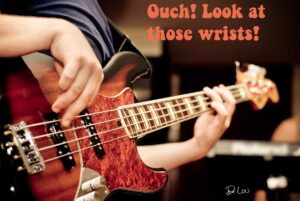The Bass Guitar & Injuries
Tools to fight arm and hand injuries.
You are today, the sum of all your experiences, practices, gigs, accidents, stressors, and jobs. One of the biggest mistakes when working to prevent or resolve playing injuries is sometimes focusing too much on the instrument, it’s balance and position, and not enough on your day to day activities.

Ouch! Those wrists are going to see some carpal tunnel pain! Bass player injuries can be prevented. They can also be healed without drugs and surgery, at home, without frequent visits to providers. Call Dr. Lou, Maine’s “Rock Doc.” (207) 774-6251. Telemedicine available worldwide.
“Good practices” are not as simple as warming up, taking breaks, and cooling down after play!!!”
PRMD’s or “playing-related musculoskeletal disorders” are common among guitarists of all types. In bass players, repetitive stress injuries of the forearm, shoulder, neck, elbow, wrist, and hand are especially common. The length of the neck, string tension, and action, the weight of the guitar, arm and hand position, fingering techniques all make the bass guitar a moderate to high-risk instrument. From Carpal tunnel syndrome, and trigger fingers, to tennis elbow, there are many controllable factors and methods for reducing your risk of injury that you may not be aware of.
Thinking beyond warming up, taking breaks, and cooling down after play.
Warming up, taking regular and restful breaks, as well as cooling down after playing, much like in an athlete, have great value. Less obvious are those factors of one’s daily life that need to be considered when discussing injury prevention and resolution.
Do you work on a computer all day? Do you sit at a desk? Where are your arms when you sleep? Are you well hydrated? Do you play video games, cook often, golf, play other instruments, or do you like to go fishing? All of these and hundreds of other factors like long commutes, may make you more vulnerable to injury in the presence of practice and performing.
Do you have previous injuries? Previous injuries, while presumed to be resolved, may still create problems and vulnerabilities for the guitarist. This is because patients are often considered healed when they no longer hurt. But is that “healed?” Old injuries can “silently” screw you up pretty badly. If scar tissue, inflammation, surgical reconstruction, or other changes are left in the wake of an old injury, they may complicate and contribute to your current or future situation. Lack of pain does not equate to being healed. Your healthcare provider should explain their definition and expectations of “healed.” How do they measure “healed,” what are the doctor’s parameters? Are their expectations aligned with yours? Are they providing you with a plan to maintain healthy stability with an injury, after the pain is gone? A strategy for thoroughly stabilizing and optimizing your function should be discussed and implemented
Lighter Bass or Bigger Back and Biceps?

Ouch! Those wrists are going to see some carpal tunnel pain! Bass player injuries can be prevented. They can also be healed without drugs and surgery, at home, without frequent visits to providers. Call Dr. Lou, Maine’s “Rock Doc.” (207) 774-6251. Telemedicine available worldwide.
A lightweight bass guitar is generally considered to be 8 to 10 pounds with an average bass being 10 or more pounds. 12 pounds is where heavier basses fall on the spectrum. The Ibanez Mikro GSRM20BS 4 String Bass Guitar is one of the lighter basses at between 6 to 7 pounds. Davidson Guitars makes a full size that weighs as little as 3 pounds! The heavier the guitar, the greater the potential strain. Anything you do with a heavier guitar, much like a heavier dumbbell, will add stress to your activity. With stress comes the potential for injury. This is one area, the guitar purchase, that you have flexibility and choices.
Both lighter instruments and strengthening are great options to reduce stress on your body. Strategic exercises, done safely will build strength and resilience which will also reduce accumulated stress on your body from the weight of the guitar, length of playtime, as well as position, technique, intensity, stance, and the like.
As a general rule, the stronger you are, the more resilient you will be while playing. Injuries always happen for a reason, and often multiple reasons. Considering a strategic exercise routine designed specifically for the demands on your body from your instrument and playing schedule should dramatically reduce injury risk. It will also allow you to play longer and harder even while under great stress. Your doctor or physical therapist should provide you with these types of exercises.
Hand strength matters with ALL Guitars
If you don’t warm up, take breaks, and cool down, are you doomed?
Having worked with musicians professionally for nearly 20 years, I know that many if not most, do not warm-up, take breaks, and cool down. I’m here to tell you, that while those things should be done, you can sometimes get away with making other changes and additions to your daily routine that will have just as great of an impact on injury healing and prevention.
Exercise strategically for playing and DO THIS!
Adjust the action on your bass. Adjusting the action of your strings should reduce the amount of pressure needed from your fingers and wrists. Over time, this may result in a meaningful reduction of risk while playing.
Evaluate other life activities. Some of the biggest factors impacting the effects of playing are those activities that are unrelated to playing.
– Computer work & mouse usage
– Cooking, chopping, lifting, and flipping food.
– Driving. Arms up on the wheel with gripping?
Sleep position. Do you sleep on your arms, wrists curled, hands above the head?
Do you work with power tools or other tools of your trade that vibrate or require a firm grip?
Let your amp do the work. Experiment with different settings on your amp or even a more powerful amp. Let the amp do the work.
Consider mental stress. Mental stress increases tension, inflammation, fatigue, poor sleep, and a host of other biological processes that can make you more vulnerable to injury and slow healing.
Shop around. A different guitar may make a difference too. A slim neck, a different body, a more ergonomic bass like those made by Jerome Little and Torzal Guitars, could make enough of a difference with these other considerations, that your lack of warm-up, breaks, and cooldowns may not matter as much.
Professional musicians are specialized athletes.
Like a professional athlete or a high-performance car, you need special attention. You wouldn’t take your Ferrari to the Toyota dealership for service, and you should try to take your body to a provider familiar with your instrument and injuries.
Dr. Lou Jacobs is a chiropractor – acupuncturist in Portland, Maine who has been specializing in musician injuries and crew injuries for 20 years. Dr. Lou is available for telemedicine consultations for music-related injuries and health problems. Among some of those he has permission to mention, Dr. Lou has worked with Mumford & Sons, The Pixies, Steve Vai, Tommy Emmanuel, Ziggy Marley and the Melody Makers, Blackberry Smoke, Gogol Bordello, Trey Anastasio, and Edward Sharpe and the Magnetic Zeros. PHOTOS
